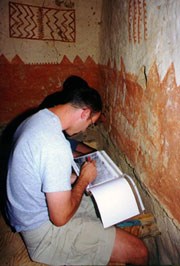|
FEDERAL AGENCY PARTNERSHIPS Over the past 12 years the Archeological Site Conservation Program (ASCP) at Mesa Verde National Park has shared its archeological expertise with many other southwestern area public lands. This support has ranged from sharing methods, forms and database standards, and staff in order to complete documentation and preservation projects. ASCP staff members from Mesa Verde have worked at archeological sites at Hovenweep NM, Navajo NM, Los Alamos National Laboratory, Canyonlands NP, Glen Canyon NRA, Gila Cliff Dwellings NM, Salinas Pueblo Missions NHP, and at sites managed by the Bureau of Land Management in Utah and Colorado, and at Forest Service properties in Colorado. 
NPS PHOTO EDUCATIONAL PARTNERSHIPS 
NPS PHOTO Fort Lewis College Fort Lewis College (FLC) located in Durango, Colorado, has established a unique program to provide internships for undergraduate students to work with park professionals at Mesa Verde National Park. Since 2002, this program has paired student interns with national park professionals and FLC mentoring faculty members. Intern projects at Mesa Verde have included archeology, natural resource management, curation, park planning, visitor education and interpretation, and GIS. Students who take advantage of the archeological internships benefit by gaining field experience in some of the best-preserved archeological sites in the world. For the college, internships provide an arena for the practical application of academic concepts and classroom training, and such programs enhance the professional interaction of two institutions with similar educational goals. For the park, fostering a relationship with the college can also provide a professional resource for programs, access to skilled and interested personnel, and provide low-cost professional-level help for specific tasks. Whether or not these experiences translate to career choices for the students, they embody real-world learning and service experiences in a supportive work environment. The internship program has been possible through the help of additional support from the Colorado State Historical Fund, the Mesa Verde Museum Association, the Fort Lewis College Foundation, and other funding sources from Mesa Verde National Park.
University of Pennsylvania

NPS PHOTO In 1994, The National Park Service and the Architectural Conservation Laboratory and Research Center (ACL) of the University of Pennsylvania began a collaboration effort to help preserve many of the earthen finishes still present in some cliff dwellings. The Conservation of Architectural Surfaces Program for Archeological Resources was designed to develop coordinated methods for the survey, analysis, stabilization, and interpretation of the masonry and architectural surface finishes in the cliff dwellings of Mesa Verde National Park. Funding for this effort has been provided by The Getty Grant Program, National Park Service, Colorado Historical Society, The Samuel H. Kress Foundation, and the Ballantine Family Fund. This partnership has resulted in the documentation and treatment of surface finishes at several cliff dwellings in the park, including Cliff Palace, Spruce Tree House, and Long House.
The Crow Canyon Archaeological Center, located in southwestern Colorado, is dedicated to understanding, teaching, and preserving the rich history of the Ancestral Pueblo Indians who inhabited the canyons and mesas of the Mesa Verde region more than 700 years ago. Mesa Verde National Park and Crow Canyon have partnered over the years to map Yucca House National Monument and to interpret the prehistory of the area. In 2007, Crow Canyon and Mesa Verde again worked together to study the effects of long-term interaction between humans, their cultures, and the environment within what is now the national park. This project uses computer models to determine the amount of resources available to Ancestral Puebloan populations during their occupation of the mesa and where those resources were most plentiful. Research is ongoing and findings from this project will add significantly to the overall interpretation of the prehistoric occupation of the park.
CyArk is a nonprofit organization whose mission is to digitally preserve cultural heritage sites through collecting, archiving, and providing open access to data created by laser scanning, digital modeling, and other state-of-the-art technologies. Using staff from Texas Tech University, CyArk has created digital maps and images of some of the buildings in Spruce Tree House, Fire Temple, and Square Tower House. You can view the maps at www.cyark.org.
FUNDING PARTNERSHIPS The Archeological Site Conservation Program has enjoyed the support of many private, federal and state financial contributors who share similar kinds of resource management responsibilities. In particular, the Colorado State Historical Fund assisted with getting the program underway with grants for rock art documentation, plaster preservation, and tree ring studies, and for archeological documentation projects at Cliff Palace and Spruce Tree House. Mesa Verde National Park also received a Save America's Treasures (SAT) grant in 1999. This was the first SAT grant awarded to support prehistoric resources. This program allowed an interdisciplinary staff to assess the condition of close to 150 of the park's 600 cliff dwelling sites. In addition, a grant from Tauck Tours and the Traveler's Conservation Association assisted with the condition assessment and architectural documentation condition assessment of Spruce Tree House, the most heavily visited site in the park. The Getty Grant Program supported plaster preservation research at a number of park sites, including Mug House. The World Monuments Fund, and its sponsor American Express, assisted with detailed documentation work at Spring House, a large and unique site in the Mesa Verde backcountry. Working under the auspices of the National Park Service's Vanishing Treasures Program, operational partnerships with other NPS units has led to non-destructive archeological work at Inscription House in Arizona, Gila Cliff Dwellings in southern New Mexico, the individual units of Hovenweep National Monument, and many other parks and monuments.

NPS PHOTO 
NPS PHOTO |
Last updated: April 22, 2025
